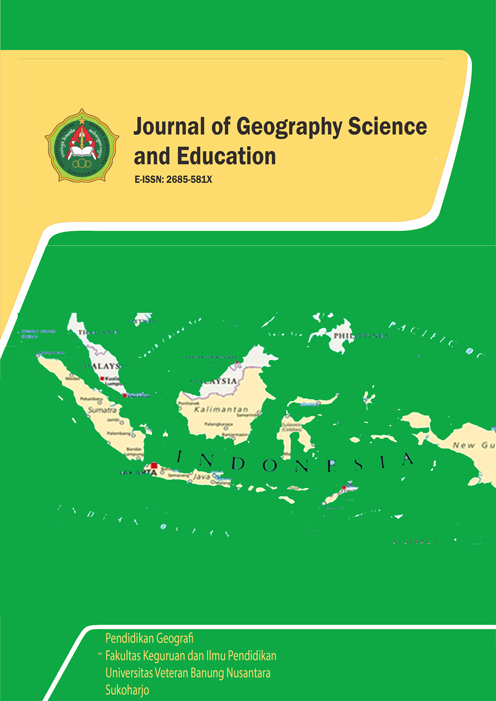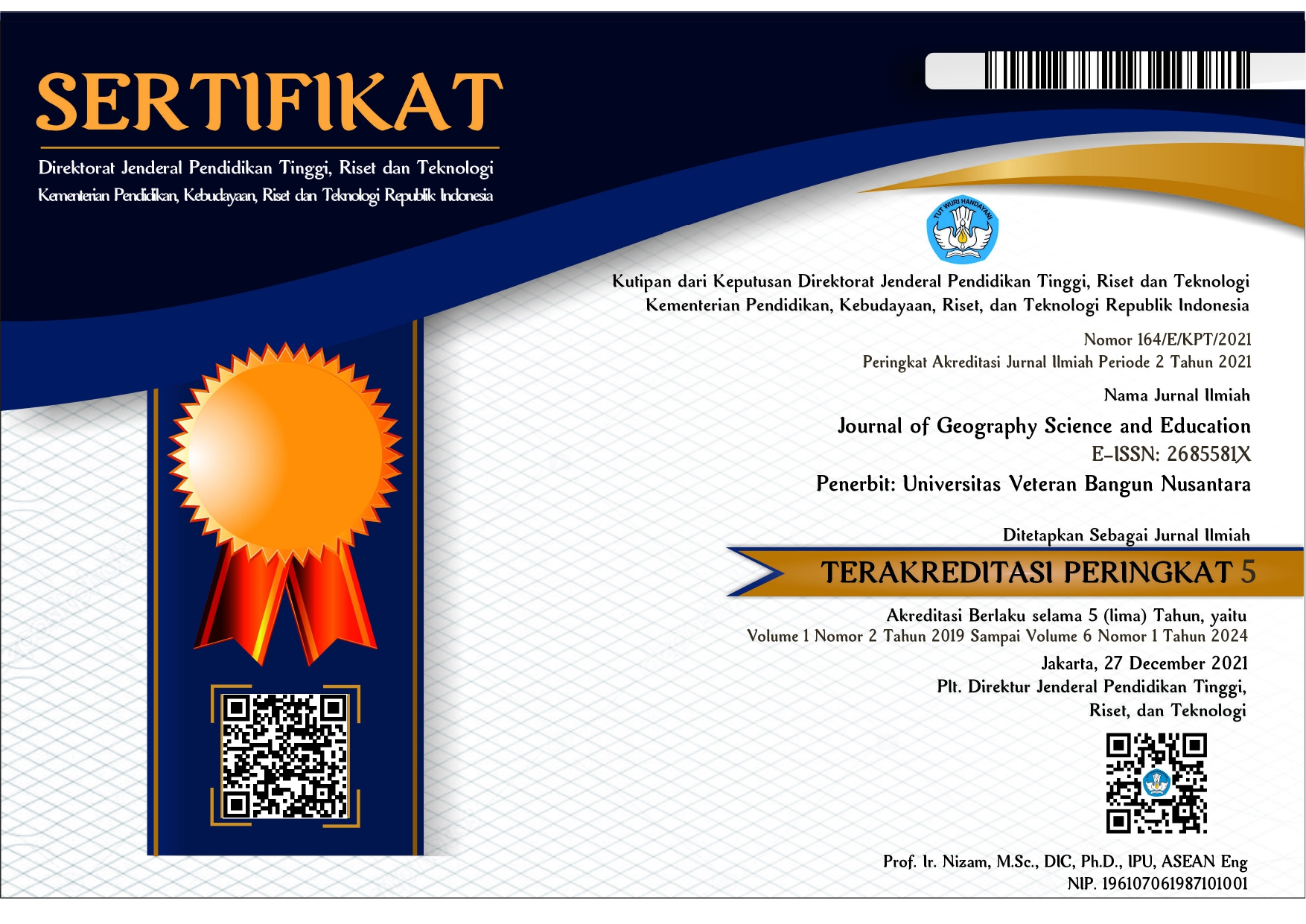Selected Measurement Parameters of Water Quality: Comparative Insight of India and Indonesia
DOI:
https://doi.org/10.32585/jgse.v4i1.2254Keywords:
Parameter Water Quality India IndonesiaAbstract
A number of rivers in India and Indonesia are usually used by the people to fulfill their daily needs. To ensure the quality of river water is in reasonable limit, it is important to monitor water quality regularly. The objective of this study was to review and compare the selection of water quality monitoring parameters in India and Indonesia. The used method was descriptive analyses. The results of the study showed several findings: first, in terms of regulation, India was lesser than that of Indonesia; second, India used the water quality index to assess the state of water quality, while Indonesia used the STORET method or the water pollution index; third, India had legally stipulated the main parameters in considering the status of water quality, whereas Indonesia had yet to stipulate it; and forth, there were 10 water quality parameters that were often used in both India and Indonesia, namely pH, BOD, COD, DO, nitrate, phosphate, temperature, TDS, TSS, and total coliform. Therefore, these parameters should be selected as the key parameters to monitor water quality.Downloads
References
Ahmad, M., Jiang, P., Majeed, A., Umar, M., Khan, Z., & Muhammad, S. (2020). The dynamic impact of natural resources, technological innovations and economic growth on ecological footprint: An advanced panel data estimation. Resources Policy, 101817. doi:10.1016/j.resourpol.2020.101817
Bouaïcha, N., Miles , C., Beach, D., Labidi, Z., Djabri, A., Benayache, N., & Nguyen-Quang, T. (2019). Structural Diversity, Characterization and Toxicology of Microcystins. Toxins, 11(12), 714. doi:https://doi.org/10.3390/toxins11120714
Casero, M., Velázquez, D., Medina-Cobo, M., Quesada, A., & Cirés, S. (2019). Unmasking the identity of toxigenic cyanobacteria driving a multi-toxin bloom by high-throughput sequencing of cyanotoxins genes and 16S rRNA metabarcoding. Science of The Total Environment, 665, 367-378. doi:https://doi.org/10.1016/j.scitotenv.2019.02.083
CPCB, Central Pollution Control Board. (1992). Water Quality Requirement for Different Uses. doi:http://117.252.14.242/rbis/india_information/water%20quality%20standards.htm
Dixit, R., Patel, A., Toppo, K., & Nayaka, S. (2017). Emergence of toxic cyanobacterial species in the Ganga River, India, due to excessive nutrient loading. Ecological Indicators, 72, 420-427. doi:https://doi.org/10.1016/j.ecolind.2016.08.038
Kaebernick, M., & Neilan, B. (2001). Ecological and molecular investigations of cyanotoxin production. FEMS Microbiology Ecology, 35(1), 1-9. doi:https://doi.org/10.1111/j.1574-6941.2001.tb00782.x
Kamboj, N., & Kamboj, V. ( 2019). Water quality assessment using overall index of pollution in riverbed-mining area of Ganga-River Haridwar, India. Water Science, 33(1), 65-74. doi:https://doi.org/10.1080/11104929.2019.1626631
Kawabata, M., Fujii, T., Kameya, T., & Kobayashi, T. (2007). Characteristics of Continuous Water Quality. Japanese Journal of Water Treatment Biology, 43, 219-226.
Kesari, V., Kumar, S., Yadav, I., Chatterjee, A., Rai, S., & Pandey, S. (2021). Ganga river water quality assessment using combined approaches: physico-chemical parameters and cyanobacterial toxicity detection with special reference to microsystins and molecular characterization of microcystin (mcy) genes carrying cyanobacteria. Environmental Science and Pollution Research , 29, 13122–13140. doi:https://doi.org/10.1007/s11356-021-16589-1
Kusumastuti, A., Bisri, B., Solichin, C., & P, D. (2021). Water Quality Monitoring and Evaluation in the Bengawan. IOP Conf. Series: Earth and Environmental Science, 012024. doi:10.1088/1755-1315/641/1/012024
Lai, Y., & Dzombak, D. (2021). Assessing the Effect of Changing Ambient Air Temperature on Water Temperature and Quality in Drinking Water Distribution Systems. MDPI AG, 13(14), 1916. doi:https://doi.org/10.3390/w13141916
Liu, J., Liu, L., Yang, G., & Wang, X. (2012). A novel approach to rapid detection of acute water toxicity and its policy implications for grassroots sustainable environmental monitoring. Journal of Environmental Monitoring, 1196 - 1223. doi:10.1039/c2em11010e
Lusiana, E., Mahmudi, M., Hutahaean, S., Darmawan, A., Buwono, N., Arsad, S., & Musa, M. (2022). A Multivariate Technique to Develop Hybrid Water Quality Index of the Bengawan Solo River, Indonesia. Journal of Ecological Engineering 2022, 23(2), 123–131, 123-131. doi:https://doi.org/10.12911/22998993/144420
Maharani, S., Nailufhar, L., & Sugiarti, Y. (2019). Adsorption effectivity of combined adsorbent zeolite, activated charcoal, and sand in liquid waste processing of agroindustrial laboratory. IOP Conference Series: Earth and Environmental Science, 443, 012044. doi:https://dx.doi.org/10.1088/1755-1315/443/1/012044
Marhaento, H., Booij, M., & Ahmed, N. (2021). Quantifying relative contribution of land use change and climate change to streamflow alteration in the Bengawan Solo River, Indonesia. Hydrological Sciences Journal, 1059-1068. doi:10.1080/02626667.2021.1921182
Mateo, P., Leganés, F., Perona, E., Loza, V., & Fernández-Piñas, F. (2015). Cyanobacteria as bioindicators and bioreporters of environmental analysis in aquatic ecosystems. Biodiversity and Conservation, 24, 909-948. doi:https://doi.org/10.1007/s10531-015-0903-y
Miller, G., & Spoolman, S. (2018). Living in the Environment. Boston, USA: Cengage Learning.
Mitra, P., Pal, D., & Das, M. (2018). Does quality of drinking water matter in kidney stone disease: A study in West Bengal, India? Investig Clin Urol, 59(3), 158-165. doi:https://doi.org/10.4111/icu.2018.59.3.158
Ningrum, R., & Utomo, B. (2020). Relationship of River to Salinity Well Water in Bintaran Village, Sub-District Air Salek. Journal of Geography Science and Education, 2(1), 1-10. doi:https://doi.org/10.32585/jgse.v2i1.827
Novianti, N., Zaman, B., & Sarminingsih, A. (2022). Kajian Status Mutu Air dan Identifikasi Sumber Pencemaran Sungai Cidurian Segmen Hilir Menggunakan Metode Indeks Pencemaran (IP). Jurnal Ilmu Lingkungan, 20(1), 22-29. doi:10.14710/jil.20.1.22-29
Pemerintah Republik Indonesia. (2001). Peraturan Pemerintah Nomor 82 Tahun 2001 tentang Pengelolaan Kualitas Air dan Pengendalian Pencemaran Air. Jakarta: Pemerintah Republik Indonesia.
Pemerintah Republik Indonesia. (2003). Keputusan Menteri Lingkungan Hidup No. 115 Tahun 2003 Tentang Pedoman Penentuan Status Mutu Air. Jakarta: Pemerintah Republik Indonesia.
Pemerintah Republik Indonesia. (2014). Peraturan Pemerintah Nomor 44 Tahun 2014 tentang Jenis dan Tarif atas Penerimaan Negara Bukan Pajak yang berlaku di Kementerian Lingkungan Hidup dan Kehutanan. Jakarta: Pemerintah Republik Indonesia.
Puspitasari, R. (2016). Java Medaka sebagai Kandidat Bioindiator. Oseana, XLI, 19-26.
Putri, M. R., Hartini, S. T., & Satria, F. (2016). Kematian Massal Ikan dan Sebaran Parameter Kualitas Air Teluk Jakarta. Bawal, 8, 77-90.
Santoso, M., Sudargono, A., & Rahmawati, T. (2020). Utilization of land in the river border area in Grogol Sub-district Sukoharjo District in 2018. Journal of Geography Science and Education, 2(2), 43-47. doi:http://journal.univetbantara.ac.id/index.php/jgse/index
Setyaningrum, D., & Agustina, L. (2020). Analisis Kualitas Air di Daerah Aliran Sungai Bengawan Solo Wilayah Kabupaten Bojonegoro. Samakia: Jurnal Ilmu Perikanan, 1-9.
Siddiqui , E., & Pandey, J. (2019). Temporal and spatial variations in carbon and nutrient loads, ion chemistry and trophic status of the Ganga River: a watershed-scale study. Limnology , 20, 225-266. doi:https://doi.org/10/1007/s1020-019-00575-1
Velusamy, K., Periyasamy, S., Kumar, P. S., Vo, D.-V., Sindhu, J., Sneka, D., & Subhashini, B. (2021). Advanced techniques to remove phosphates and nitrates from waters: a review. Environmental Chemistry Letters, 19, 3165-3180. doi:https://dx.doi.org/10.1007/s10311-021-01239-2
Vuuren, D., & Bouwman, L. (2005). Exploring past and future changes in the ecological footprint for world regions. Ecological Economics, 43-62. doi:10.1016/j.ecolecon.2004.06.009
Wagner, N., Osburn , F., Wang, J., Taylor, R., Boedecker , A., Chambliss , C., . . . Scott , J. (2019). Biological Stoichiometry Regulates Toxin Production in Microcystis aeruginosa (UTEX 2385). Toxins, 11(10), 601. doi:https://doi.org/10.3390/toxins11100601
World Health Organization. (2011). Guidelines for Drinking-water Quality. Geneva, Switzerland: 4th end WHO.
Zheng, H., Liu, R., Zhang, R., & Hu, Y. ( 2014). A method for real-time measurement of respiratory rhythms in medaka (Oryzias latipes) using computer vision for water quality monitoring. Ecotoxicology and Environmental Safety, 100, 76-86. doi:10.1016/j.ecoenv.2013.11.016
Zheng, H., Zhang, R., Hu, Y., & Liu, R. (2014). A Research of Full-Automatic Experiment Platform Using Machine Vision for Water Quality Monitoring. Applied Mechanics and Materials, 526, 336-241. doi:https://remote-lib.ui.ac.id/login?url=https://dx.doi.org/10.4028/www.scientific.net/AMM.526.336
Downloads
Published
How to Cite
Issue
Section
License
Authors who publish with the Journal of Geography Science and Education agree to the following terms:
- Authors retain copyright and grant the journal the right of first publication with the work simultaneously licensed under a Creative Commons Attribution License (CC BY-SA 4.0) that allows others to share the work with an acknowledgment of the work's authorship and initial publication in this journal.
- Authors are able to enter into separate, additional contractual arrangements for the non-exclusive distribution of the journal's published version of the work (e.g., post it to an institutional repository or publish it in a book), with an acknowledgment of its initial publication in this journal.
- Authors are permitted and encouraged to post their work online (e.g., in institutional repositories or on their website) prior to and during the submission process, as it can lead to productive exchanges, as well as earlier and greater citation of published work.










